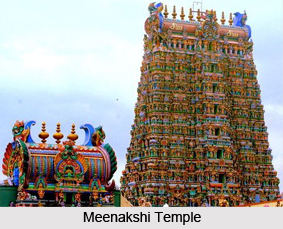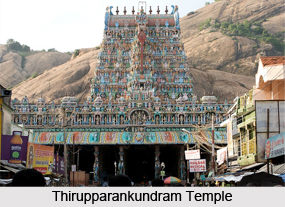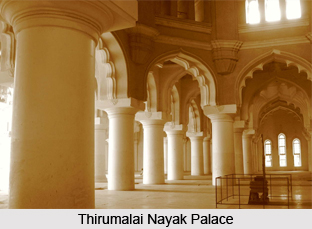 One of the most important monuments of Madurai is the Meenakshi Temple. In fact Madurai is often referred to as a temple city. Situated along the banks of the Vaigai river, it has long been a centre of pilgrimage and learning. It was home some 2000 years ago to the famous `Sangams` or the gatherings of poets and writers which is been the source of the remarkable Tamil literature. The Sangam rulers were the first to establish their supremacy over the region. The reigns then passed over to the Vijayanagara rulers and later the Nayakas. Though all were capable rulers, the rule of the Sangam rulers was the greatest era of development of Madurai in art and cultural heritage.
One of the most important monuments of Madurai is the Meenakshi Temple. In fact Madurai is often referred to as a temple city. Situated along the banks of the Vaigai river, it has long been a centre of pilgrimage and learning. It was home some 2000 years ago to the famous `Sangams` or the gatherings of poets and writers which is been the source of the remarkable Tamil literature. The Sangam rulers were the first to establish their supremacy over the region. The reigns then passed over to the Vijayanagara rulers and later the Nayakas. Though all were capable rulers, the rule of the Sangam rulers was the greatest era of development of Madurai in art and cultural heritage.
The temples, educational centres and monuments make Madurai the cradle of Indian cultural legacy. It is strewn with a number of monuments which are major tourist attractions.
Religious Monuments in Madurai
By far the greatest attraction of Madurai is the Meenakshi Sundareshwar Temple located here. It is dedicated to Lord Shiva, who is known here as Sudareshvara, and Goddess Parvati known as Meenakshi. The Temple was originally built by the Pandyas King Kulasekara. Later it was extensively worked on and renovated and added to by successive rulers.
The ancient city of Madurai supposedly was laid out in a lotus-like formation, with the temple at the center and streets and main thoroughfares layered one after the other concentrically, outward from the center. There are high walled enclosures in the temple complex the sanctums for Meenakshi and Sundareshvara are kept surrounded by other smaller shrines. There are twelve beautifully sculpted gopurams rising from solid granite bases. They are decorated with vividly painted figures of deities, mythical flowers and animals.
The temple remains open on all days and two festivals, Chitirai and Avanimoolam are celebrated with great ardor and enthusiasm.
 Thirupparankundram Temple is a rock cut Temple built by the Pandya rulers in the eighth century. It is located 7 kms southwest of Madurai.The sacred site is considered to be one of the six sacred abodes of Murugan.It is said to be the place where he married the daughter of Indra, Devyani. The beautifully carved temple is decorated with mandapas. During the months of March/April a fourteen day festival is conducted to celebrate the victory of murugan over the demon Suran.
Thirupparankundram Temple is a rock cut Temple built by the Pandya rulers in the eighth century. It is located 7 kms southwest of Madurai.The sacred site is considered to be one of the six sacred abodes of Murugan.It is said to be the place where he married the daughter of Indra, Devyani. The beautifully carved temple is decorated with mandapas. During the months of March/April a fourteen day festival is conducted to celebrate the victory of murugan over the demon Suran.
Kadal Alagar temple lies to the South West of the Meenakshi Temple and is dedicated to the Lord Vishnu. The temple contains three superimposed sanctuaries which contain Lord Vishnu. These are of gradually reducing size. It hoses Vishnu in sitting, standing and reclining positions. The outer wall has beautiful carvings and stone sculptures. The temple remains open on all days.
Alagar Koil temple is situated 12 kms north of Madurai. It is dedicated to the brother of Meenakshi, Kallagar, which is actually a form of Lord Vishnu. The small town is located at the foot of the Kalagar hills.
Anglican Cathedral can be found in the middle of the town in an open space south-west of the Great Temple of Meenakshi. It was designed by the Chennai architect Robert Fellows Chisolm and consecrated in 1881. It has been constructed in the Neo-Gothic architectural style of the British era. The church is a popular tourist attraction.
West of the main entrance to the People`s Park is the Jami Masjid, which contains two tombs: that of Ala-ud-Din Khilji and his brother Shams-ud-Din. A pillar inside is inscribed with the date 1574 and describes the sanctuary as the `Mosque of the Delhi Orukol Sultan`. The main feature of interest is the dome, cut from a single block of stone and measuring 6-7 m (22 ft) from base to apex and 21 m (69 ft) in diameter.
North of the Vaigai River are the tombs of the Madurai rulers. The sultans were buried to the North of the city. The complex of tombs includes the tomb of a local Sufi Saint, Bara Mastan Sada built in the sixteenth century, as well as Alauddin`s Mosque that has a prayer hall with a flat roof.
Historical Monuments in Madurai
Tirumalai Nayaka Palace lies to the south-cast of the Great Temple of Shree Meenakshi. This grand palace was built in 1636 by Tirumalai Nayaka. It has been constructed in the Indo-Saracenic architectural style and was originally four times as large as it is today. It was dismantled between 1662 and 1682 by Tirumala`s grandson in the transfer of the capital to Trichinopoly. Though it was partially restored in the 19th century by Lord Napier, Governor of Madras between 1866 and 1872, only a single section of the once superb complex today remains.
Today there are two oblong blocks remaining, constructed in Indo-Islamic style connected at one corner. The larger is built around a spacious open courtyard, which is surrounded by an elegant arcade. The columns are over 12-2 m (40 ft) high, enriched with foliated brick arches of finely chased chunam. Behind the arcade, three sides of the quadrangle have cloisters 43 feet wide, carved in triple rows of columns. Traces of the original turquoise, orange and red paint can still be seen on the capitals.
 At the end of the courtyard the cloister deepens into a hall with five rows of massive pillars and three great domes .The main entrance portico was built to commemorate Lord Napier, the Governor of Madras from 1866 to 1872 who was responsible for its restoration.
At the end of the courtyard the cloister deepens into a hall with five rows of massive pillars and three great domes .The main entrance portico was built to commemorate Lord Napier, the Governor of Madras from 1866 to 1872 who was responsible for its restoration.
The Palace consisted mainly of two parts, the Swargavilasa and the Rangavilasa. This palace consisted mainly of two parts, namely Swargavilasa and Rangavilasa which house the royal residence, theatre, shrine, apartments, armory, palanquin place, royal bandstand, quarters, pond and gardens.
To the west and opposite the main entrance is the Celestial Pavilion or Swarga Vilasam, which was once the throne-room. It consists of an arcaded octagon, covered by a dome. It is evidence of the remarkable building skills of the engineers as it stands 20 ft high without any support.
There is another hall to the North of this which is high and lofty. It is covered by a pointed arched roof and reinforced with granite ribs which spring from a double series of arches, one above the other, carried on columns. In each corner is the carved figure of a warrior with a drawn sword. Above is a large gallery. Tradition asserts that this was Tirumala`s sleeping-apartment, with the bed suspended by chains from the ceiling.
A light and sound show is a major attraction for visitors and tourists. These are based on the lives of Tirumalai Nayak.
Madurai abounds in culture, heritage art and education. The ancient Indian tradition of education and worship are still seen preserved in this historical city.




